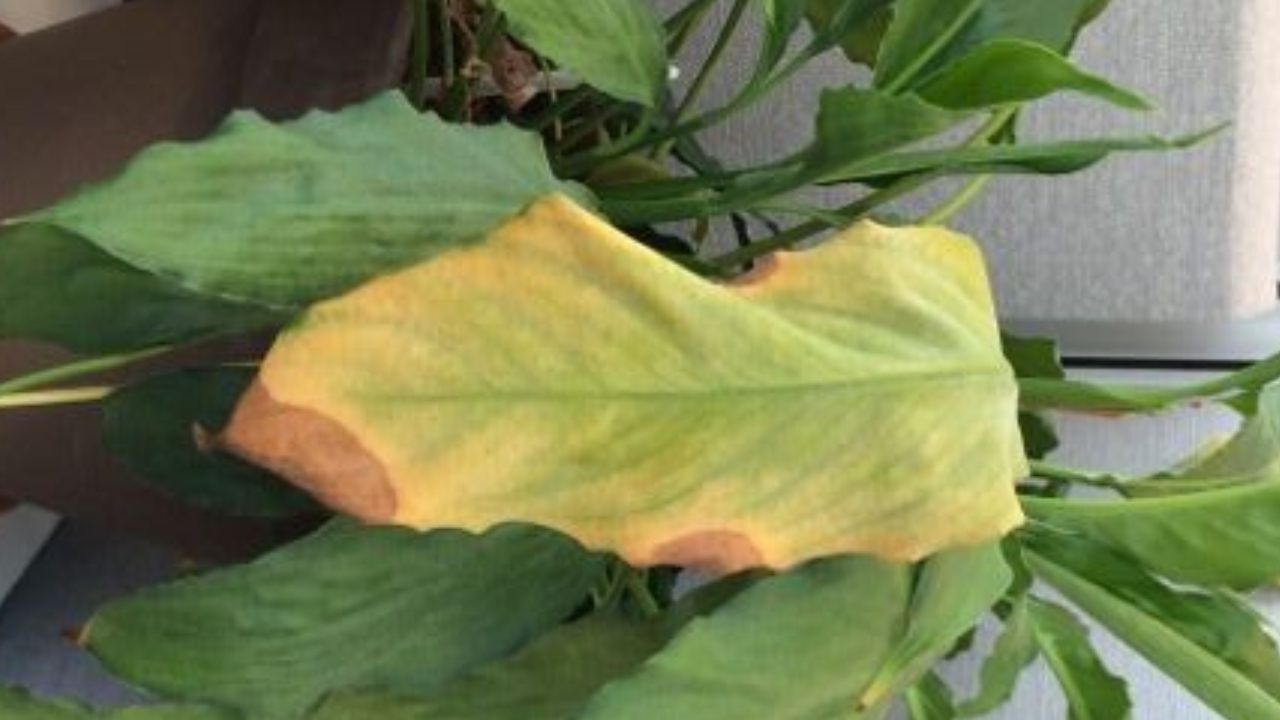If you have planted a Peace Lily plant in your house, then at some point of time your plant must have been attacked by mildew. This mildew gradually destroys the Peace Lily plant completely, due to which the Peace Lily plant gets spoiled. This mildew can be of many types.
Common Fungal Infections in Peace Lily
If you don’t identify these fungal infections properly, you will not be able to cure this infection, so first identify the infection and treat it properly. Here are some fungal infections in peace lily.
Root Rot

Root rot is one of the most common problems in peace lily and it is usually caused by overwatering or poor drainage. Fungi such as Pythium, Phytophthora, and Rhizoctonia thrive in overly wet soil, causing the roots to rot.
Symptoms:
You will need to look for the following symptoms to identify root rot:
- Yellowing leaves
- Wilting despite adequate watering
- Smelly, black or rotten roots
Treatment
Once you have confirmed that your peace lily plant has root rot infection, here is how you can treat it:
Repot the plant: First, remove the peace lily from its pot and then wash the roots thoroughly in clean water. After washing, cut off any rotten or blackened roots with sterilized scissors.
Use a fungicide: Apply a fungicide to the remaining healthy roots to specifically treat root rot.
Repot: Prepare well-draining soil before repotting the peace lily and make sure the new pot has drainage holes.
Water management: Water the plant sparingly and only when the top 1 inch of soil is dry.
Homemade fungicide option: Mix 1 part hydrogen peroxide (3%) with 2 parts water and apply to the roots. This helps to inhibit mildew and prevent further growth.
Leaf spot

Leaf spot is caused by various types of fungi and can spread quickly on the leaves of the plant. Therefore, it is important to prevent this disease by first identifying the disease.
Symptoms:
The first symptom of leaf spot is that over time the leaves of the peace lily turn brown, with black or yellow spots on the leaves.
The second symptom of leaf spot is that the leaf tissue can die.
Treatment
Prune the affected leaves: When you find out that your plant has leaf spot disease, the first thing you should do is remove the damaged leaves so that the disease does not spread to the entire plant.
Apply fungicide: If you do not want to remove the leaves, then you can spray a fungicide on the leaves.
Improve airflow: Make sure the plant is not too dense, as this blocks air circulation, so you should keep the plant well ventilated.
Natural treatment tip: Neem oil acts as a fungicide and insect repellent. Mix 1 teaspoon of neem oil with 1 quart of water and a few drops of dish soap. Spray this solution on the affected areas every 7-14 days.
Powdery mildew

This disease is very rare in peace lily plants. It mainly appears as a white, powdery coating on the leaves and can inhibit the growth of the plant. Therefore, it is very important to remove this disease, you can identify its symptoms in this way.
Symptoms:
- It usually has only two symptoms
- White patches on leaves
- Deformed or colorless leaves
Treatment
If the peace lily gets powdery mildew disease, then you should adopt these methods and your plant will become green.
Isolate the plant: Keep the infected peace lily away from other plants to prevent spread.
Wipe the leaves: Gently wipe the affected areas with a wet cloth to remove visible mildew.
Apply fungicide: Use a fungicide formulated for powdery mildew, or apply a homemade solution of 1 tablespoon baking soda mixed with 1 quart water and a few drops of liquid soap.
Ways to prevent infection of Peace Lily
If you want your Peace Lily plant to always remain healthy and free from fungal infection, then you should adopt this method, this method will always keep your plant healthy.
Proper watering method
If you overwater the Peace Lily plant, it increases the fungal problems, so water only when the top 1-2 inches of the soil starts drying. Make sure that the pot has enough drainage holes so that water does not accumulate at the bottom.
Adequate airflow
Maintain good airflow around the plant so that the humidity level is reduced, this reduces the growth of fungal growth. Always keep the Peace Lily plant in an open space, so that air circulation is always maintained
Regular cleaning
Wipe the leaves of the peace lily with a wet cloth from time to time to remove dust and debris, which prevents the spread of mold spores
Conclusion
If you take good care of the peace lily plant, you can protect it from infection. If your plant gets attacked by mold infection, then it can be cured very easily, first identify the symptoms of infection and then treat it. Without knowing the infection, it cannot be treated. To remove any kind of infection, it is first necessary to identify its infection.
FAQS
Q. Peace lily fungus treatment hydrogen peroxide?
Ans. It is important to maintain the health of peace lily so that it can avoid fungal infection and retain its beauty. Keep the plant clean regularly and follow a proper watering method, which will maintain the moisture balance in the soil. If your peace lily plant gets fungal infection, then you can mix 1 part hydrogen peroxide (3%) with 2 parts water and pour this solution on the soil. It kills the fungal spores and keeps the roots clean. This is how you can deal with fungal disease using hydrogen peroxide.
Q. Best fungicide for peace lily?
Ans. Carbendazim: It is an effective fungicide that helps in protecting the roots and leaves of the plant from fungus.
Mancozeb: It is a broad-spectrum fungicide that controls various types of fungi and protects the leaves from damage.
Copper-based fungicide (copper sulphate): This is an organic option that is good for mild fungal infections on plants. It is safe to use and effective.Peace Lily Fungus Treatment: Effective Solutions for a Healthier Plant.
READ NEXT: Easy Steps to Growing a Mulberry Tree from Cuttings: A Complete Guide for Beginners

Hi! I’m Thayer Cruz, the creator of MysteriousGardening. I hold a Bachelor’s degree in Horticulture and Landscape Architecture from Purdue University, United States. My passion for plants and gardening grew during my studies, where I learned about everything from soil science to plant care.
Through MysteriousGardening, I share practical gardening tips, creative ideas, and insights from both my education and personal experience. Whether you’re growing your first plant or managing a full garden, I’m here to help make gardening fun and rewarding. Let’s grow something amazing together!

